Applied Field Methods in Public Health Assignment
VerifiedAdded on 2021/02/20
|13
|3098
|249
AI Summary
Contribute Materials
Your contribution can guide someone’s learning journey. Share your
documents today.
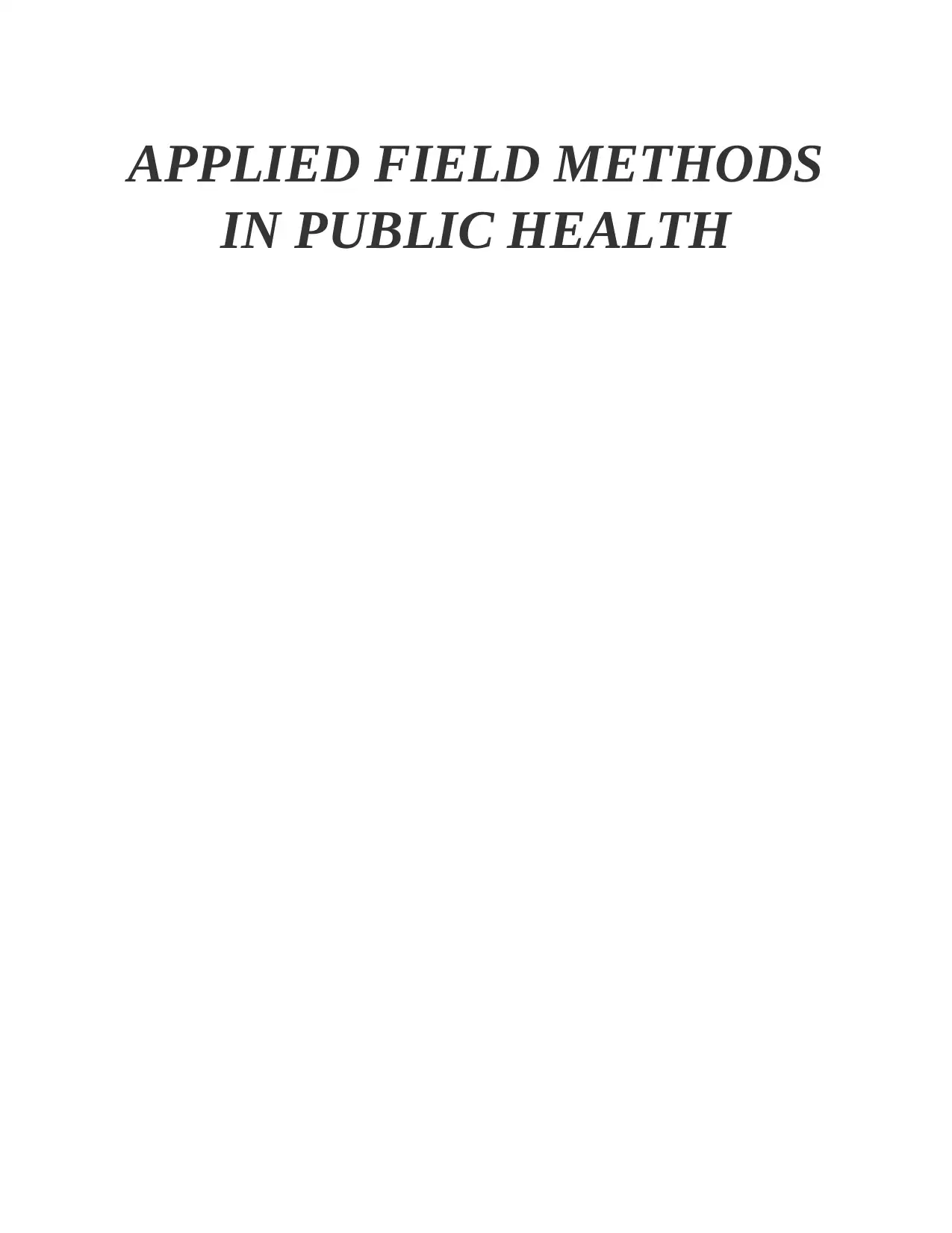
APPLIED FIELD METHODS
IN PUBLIC HEALTH
IN PUBLIC HEALTH
Secure Best Marks with AI Grader
Need help grading? Try our AI Grader for instant feedback on your assignments.
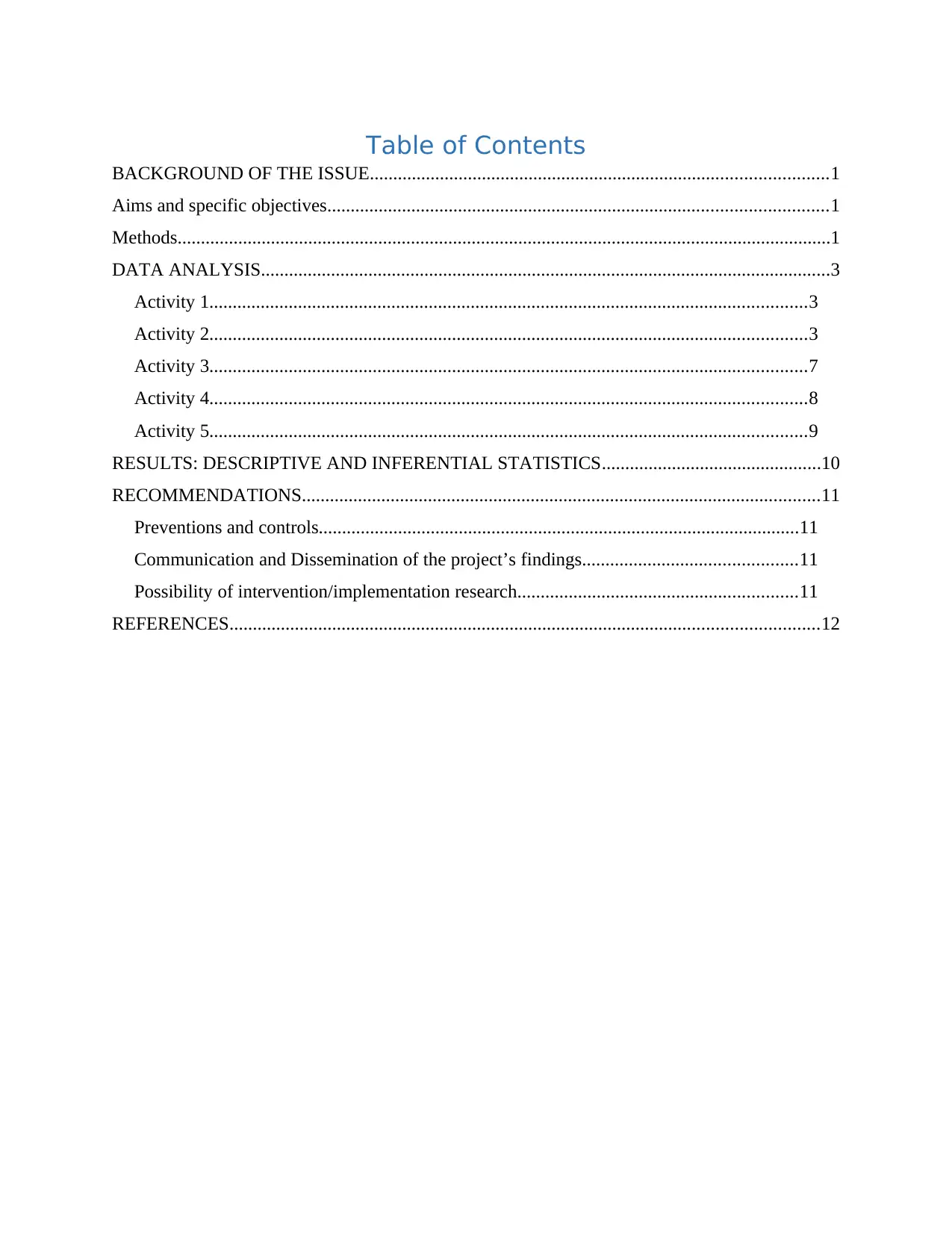
Table of Contents
BACKGROUND OF THE ISSUE..................................................................................................1
Aims and specific objectives...........................................................................................................1
Methods............................................................................................................................................1
DATA ANALYSIS..........................................................................................................................3
Activity 1................................................................................................................................3
Activity 2................................................................................................................................3
Activity 3................................................................................................................................7
Activity 4................................................................................................................................8
Activity 5................................................................................................................................9
RESULTS: DESCRIPTIVE AND INFERENTIAL STATISTICS...............................................10
RECOMMENDATIONS...............................................................................................................11
Preventions and controls.......................................................................................................11
Communication and Dissemination of the project’s findings..............................................11
Possibility of intervention/implementation research............................................................11
REFERENCES..............................................................................................................................12
BACKGROUND OF THE ISSUE..................................................................................................1
Aims and specific objectives...........................................................................................................1
Methods............................................................................................................................................1
DATA ANALYSIS..........................................................................................................................3
Activity 1................................................................................................................................3
Activity 2................................................................................................................................3
Activity 3................................................................................................................................7
Activity 4................................................................................................................................8
Activity 5................................................................................................................................9
RESULTS: DESCRIPTIVE AND INFERENTIAL STATISTICS...............................................10
RECOMMENDATIONS...............................................................................................................11
Preventions and controls.......................................................................................................11
Communication and Dissemination of the project’s findings..............................................11
Possibility of intervention/implementation research............................................................11
REFERENCES..............................................................................................................................12
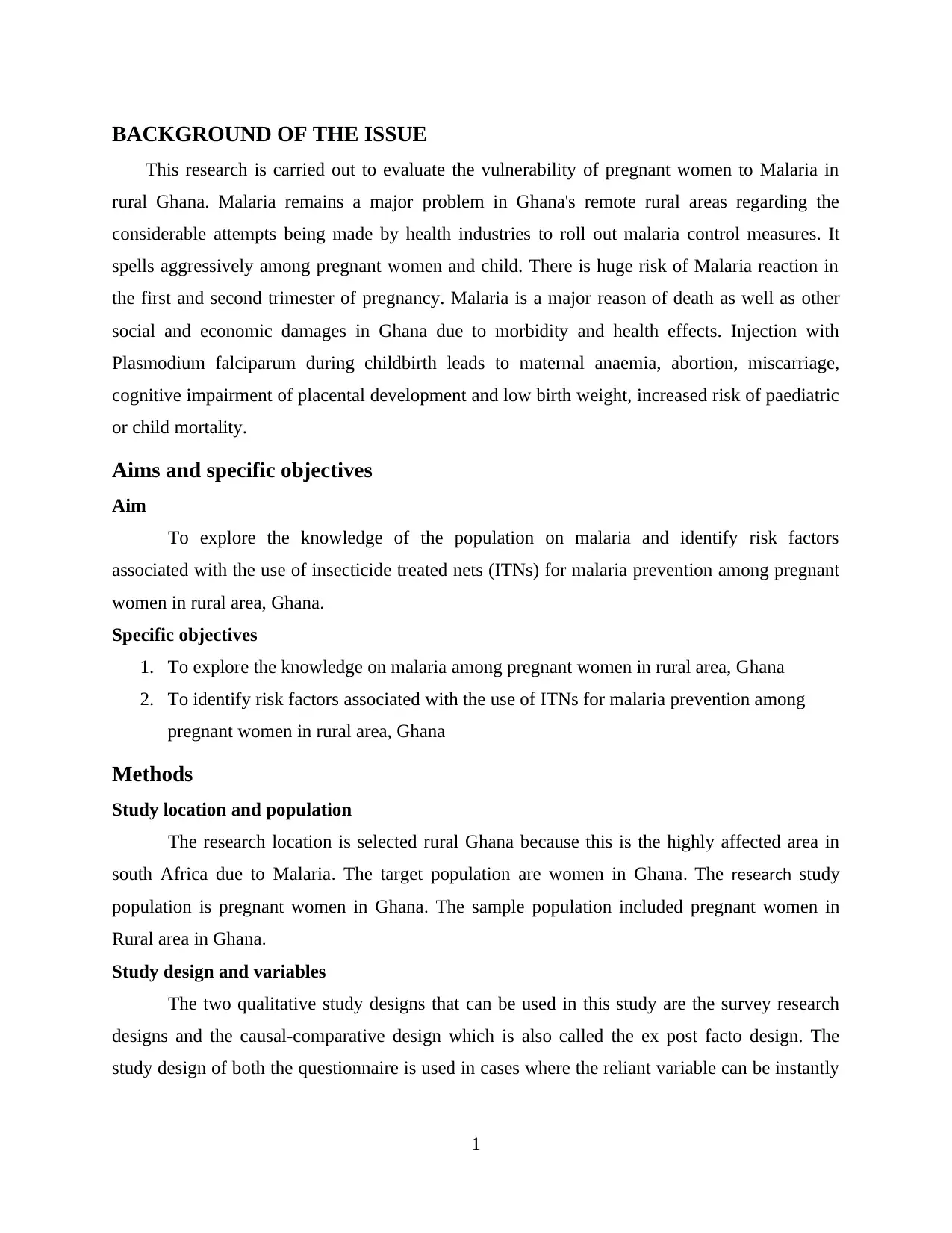
BACKGROUND OF THE ISSUE
This research is carried out to evaluate the vulnerability of pregnant women to Malaria in
rural Ghana. Malaria remains a major problem in Ghana's remote rural areas regarding the
considerable attempts being made by health industries to roll out malaria control measures. It
spells aggressively among pregnant women and child. There is huge risk of Malaria reaction in
the first and second trimester of pregnancy. Malaria is a major reason of death as well as other
social and economic damages in Ghana due to morbidity and health effects. Injection with
Plasmodium falciparum during childbirth leads to maternal anaemia, abortion, miscarriage,
cognitive impairment of placental development and low birth weight, increased risk of paediatric
or child mortality.
Aims and specific objectives
Aim
To explore the knowledge of the population on malaria and identify risk factors
associated with the use of insecticide treated nets (ITNs) for malaria prevention among pregnant
women in rural area, Ghana.
Specific objectives
1. To explore the knowledge on malaria among pregnant women in rural area, Ghana
2. To identify risk factors associated with the use of ITNs for malaria prevention among
pregnant women in rural area, Ghana
Methods
Study location and population
The research location is selected rural Ghana because this is the highly affected area in
south Africa due to Malaria. The target population are women in Ghana. The research study
population is pregnant women in Ghana. The sample population included pregnant women in
Rural area in Ghana.
Study design and variables
The two qualitative study designs that can be used in this study are the survey research
designs and the causal-comparative design which is also called the ex post facto design. The
study design of both the questionnaire is used in cases where the reliant variable can be instantly
1
This research is carried out to evaluate the vulnerability of pregnant women to Malaria in
rural Ghana. Malaria remains a major problem in Ghana's remote rural areas regarding the
considerable attempts being made by health industries to roll out malaria control measures. It
spells aggressively among pregnant women and child. There is huge risk of Malaria reaction in
the first and second trimester of pregnancy. Malaria is a major reason of death as well as other
social and economic damages in Ghana due to morbidity and health effects. Injection with
Plasmodium falciparum during childbirth leads to maternal anaemia, abortion, miscarriage,
cognitive impairment of placental development and low birth weight, increased risk of paediatric
or child mortality.
Aims and specific objectives
Aim
To explore the knowledge of the population on malaria and identify risk factors
associated with the use of insecticide treated nets (ITNs) for malaria prevention among pregnant
women in rural area, Ghana.
Specific objectives
1. To explore the knowledge on malaria among pregnant women in rural area, Ghana
2. To identify risk factors associated with the use of ITNs for malaria prevention among
pregnant women in rural area, Ghana
Methods
Study location and population
The research location is selected rural Ghana because this is the highly affected area in
south Africa due to Malaria. The target population are women in Ghana. The research study
population is pregnant women in Ghana. The sample population included pregnant women in
Rural area in Ghana.
Study design and variables
The two qualitative study designs that can be used in this study are the survey research
designs and the causal-comparative design which is also called the ex post facto design. The
study design of both the questionnaire is used in cases where the reliant variable can be instantly
1
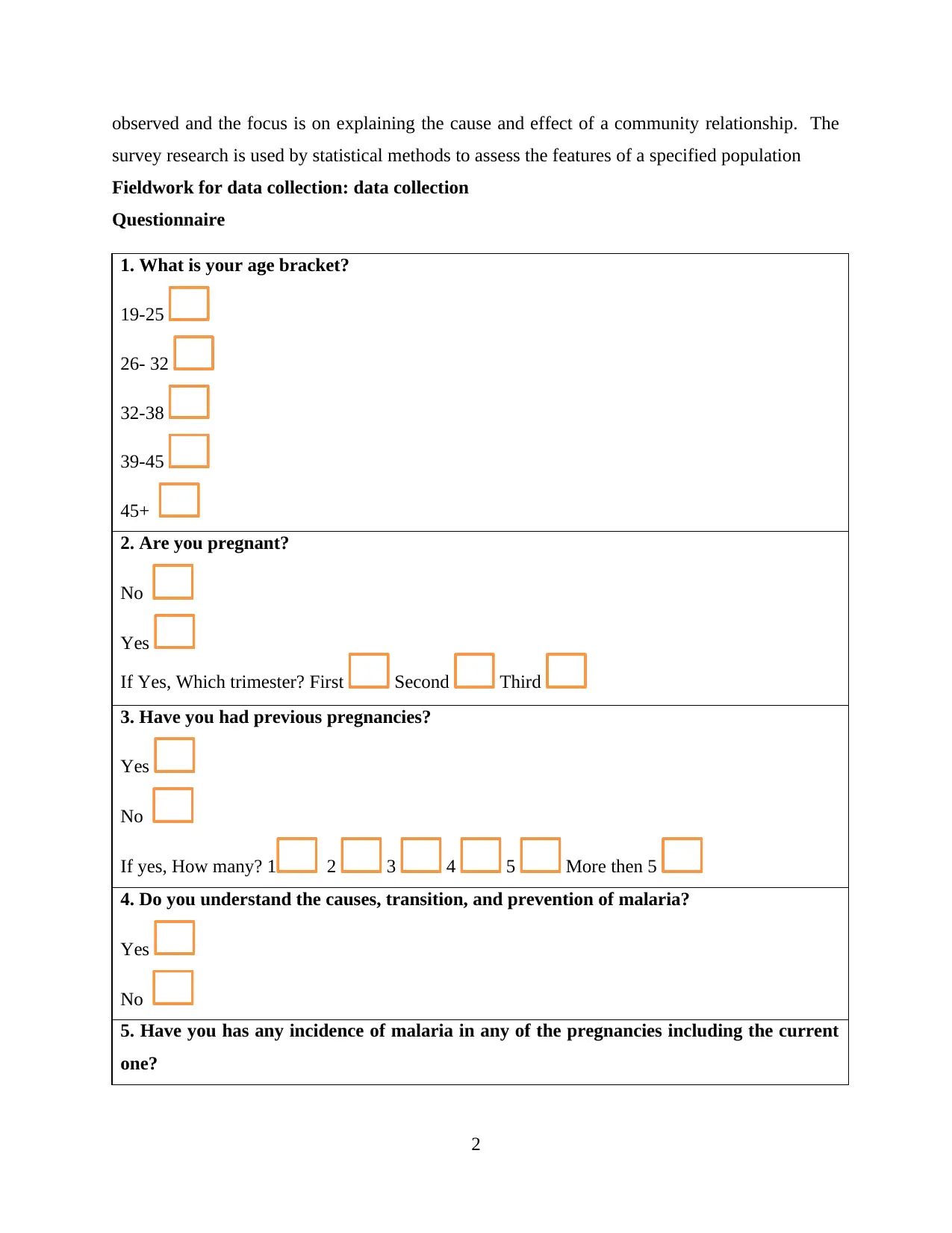
observed and the focus is on explaining the cause and effect of a community relationship. The
survey research is used by statistical methods to assess the features of a specified population
Fieldwork for data collection: data collection
Questionnaire
1. What is your age bracket?
19-25
26- 32
32-38
39-45
45+
2. Are you pregnant?
No
Yes
If Yes, Which trimester? First Second Third
3. Have you had previous pregnancies?
Yes
No
If yes, How many? 1 2 3 4 5 More then 5
4. Do you understand the causes, transition, and prevention of malaria?
Yes
No
5. Have you has any incidence of malaria in any of the pregnancies including the current
one?
2
survey research is used by statistical methods to assess the features of a specified population
Fieldwork for data collection: data collection
Questionnaire
1. What is your age bracket?
19-25
26- 32
32-38
39-45
45+
2. Are you pregnant?
No
Yes
If Yes, Which trimester? First Second Third
3. Have you had previous pregnancies?
Yes
No
If yes, How many? 1 2 3 4 5 More then 5
4. Do you understand the causes, transition, and prevention of malaria?
Yes
No
5. Have you has any incidence of malaria in any of the pregnancies including the current
one?
2
Secure Best Marks with AI Grader
Need help grading? Try our AI Grader for instant feedback on your assignments.
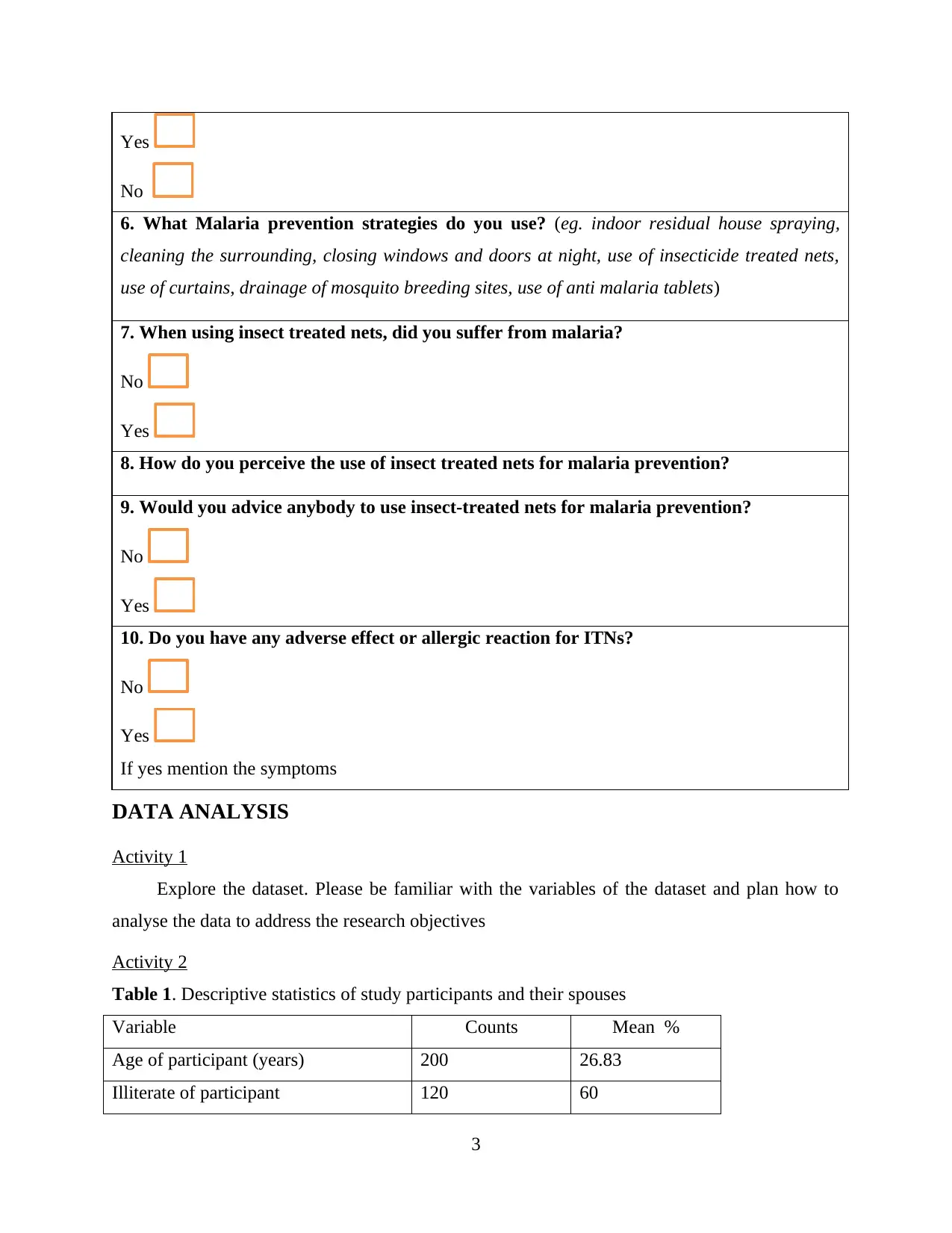
Yes
No
6. What Malaria prevention strategies do you use? (eg. indoor residual house spraying,
cleaning the surrounding, closing windows and doors at night, use of insecticide treated nets,
use of curtains, drainage of mosquito breeding sites, use of anti malaria tablets)
7. When using insect treated nets, did you suffer from malaria?
No
Yes
8. How do you perceive the use of insect treated nets for malaria prevention?
9. Would you advice anybody to use insect-treated nets for malaria prevention?
No
Yes
10. Do you have any adverse effect or allergic reaction for ITNs?
No
Yes
If yes mention the symptoms
DATA ANALYSIS
Activity 1
Explore the dataset. Please be familiar with the variables of the dataset and plan how to
analyse the data to address the research objectives
Activity 2
Table 1. Descriptive statistics of study participants and their spouses
Variable Counts Mean %
Age of participant (years) 200 26.83
Illiterate of participant 120 60
3
No
6. What Malaria prevention strategies do you use? (eg. indoor residual house spraying,
cleaning the surrounding, closing windows and doors at night, use of insecticide treated nets,
use of curtains, drainage of mosquito breeding sites, use of anti malaria tablets)
7. When using insect treated nets, did you suffer from malaria?
No
Yes
8. How do you perceive the use of insect treated nets for malaria prevention?
9. Would you advice anybody to use insect-treated nets for malaria prevention?
No
Yes
10. Do you have any adverse effect or allergic reaction for ITNs?
No
Yes
If yes mention the symptoms
DATA ANALYSIS
Activity 1
Explore the dataset. Please be familiar with the variables of the dataset and plan how to
analyse the data to address the research objectives
Activity 2
Table 1. Descriptive statistics of study participants and their spouses
Variable Counts Mean %
Age of participant (years) 200 26.83
Illiterate of participant 120 60
3
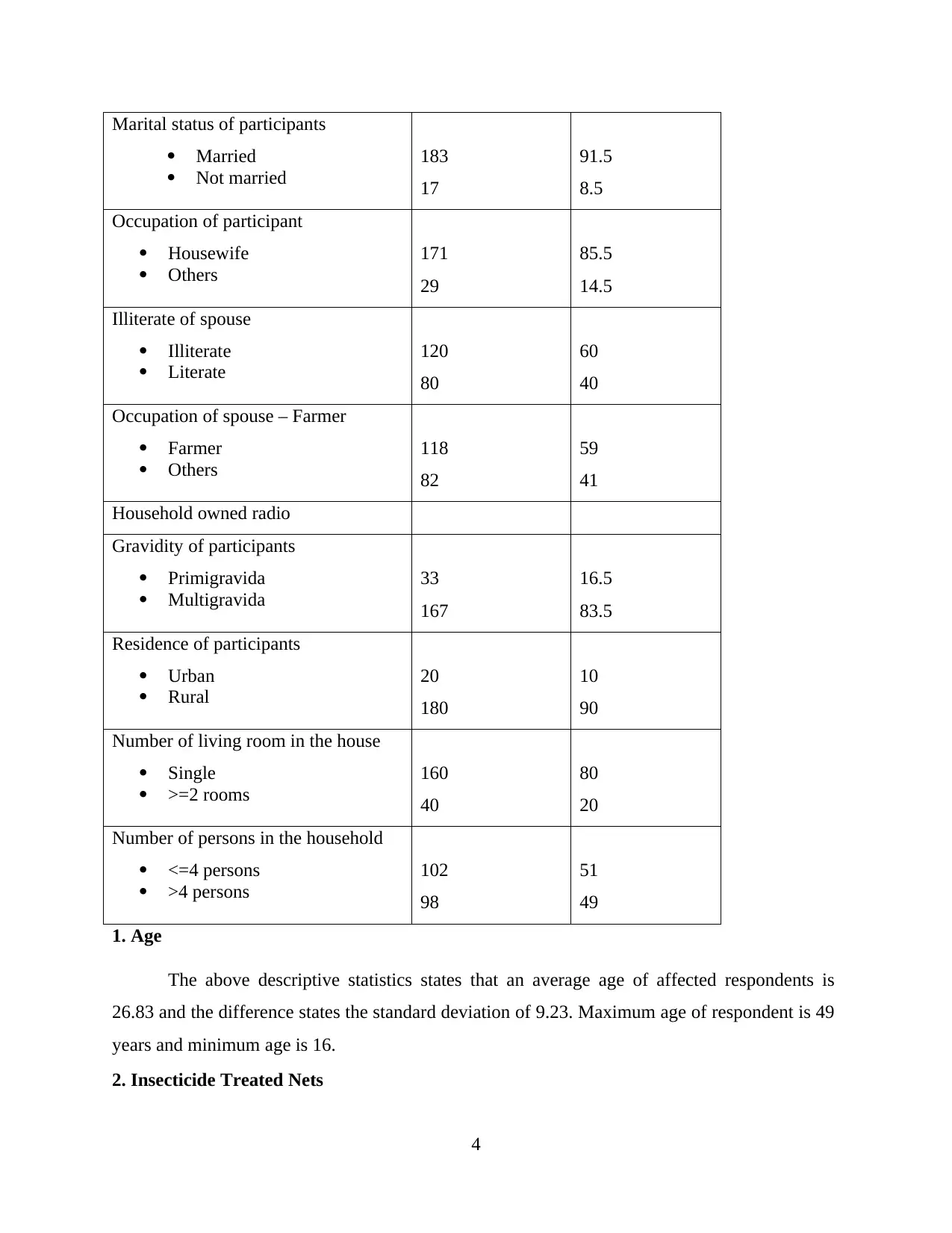
Marital status of participants
Married
Not married
183
17
91.5
8.5
Occupation of participant
Housewife
Others
171
29
85.5
14.5
Illiterate of spouse
Illiterate
Literate
120
80
60
40
Occupation of spouse – Farmer
Farmer
Others
118
82
59
41
Household owned radio
Gravidity of participants
Primigravida
Multigravida
33
167
16.5
83.5
Residence of participants
Urban
Rural
20
180
10
90
Number of living room in the house
Single
>=2 rooms
160
40
80
20
Number of persons in the household
<=4 persons
>4 persons
102
98
51
49
1. Age
The above descriptive statistics states that an average age of affected respondents is
26.83 and the difference states the standard deviation of 9.23. Maximum age of respondent is 49
years and minimum age is 16.
2. Insecticide Treated Nets
4
Married
Not married
183
17
91.5
8.5
Occupation of participant
Housewife
Others
171
29
85.5
14.5
Illiterate of spouse
Illiterate
Literate
120
80
60
40
Occupation of spouse – Farmer
Farmer
Others
118
82
59
41
Household owned radio
Gravidity of participants
Primigravida
Multigravida
33
167
16.5
83.5
Residence of participants
Urban
Rural
20
180
10
90
Number of living room in the house
Single
>=2 rooms
160
40
80
20
Number of persons in the household
<=4 persons
>4 persons
102
98
51
49
1. Age
The above descriptive statistics states that an average age of affected respondents is
26.83 and the difference states the standard deviation of 9.23. Maximum age of respondent is 49
years and minimum age is 16.
2. Insecticide Treated Nets
4
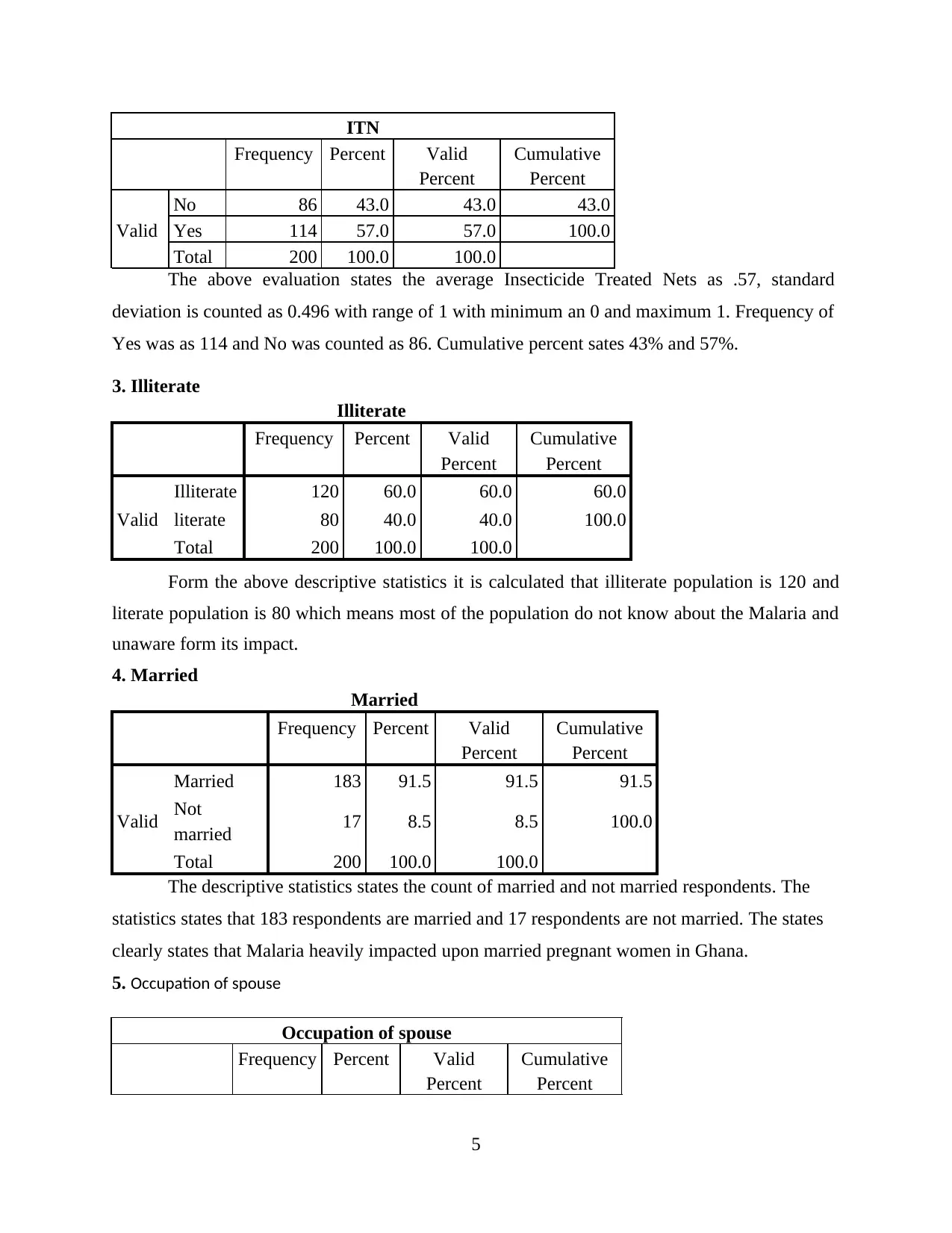
ITN
Frequency Percent Valid
Percent
Cumulative
Percent
Valid
No 86 43.0 43.0 43.0
Yes 114 57.0 57.0 100.0
Total 200 100.0 100.0
The above evaluation states the average Insecticide Treated Nets as .57, standard
deviation is counted as 0.496 with range of 1 with minimum an 0 and maximum 1. Frequency of
Yes was as 114 and No was counted as 86. Cumulative percent sates 43% and 57%.
3. Illiterate
Illiterate
Frequency Percent Valid
Percent
Cumulative
Percent
Valid
Illiterate 120 60.0 60.0 60.0
literate 80 40.0 40.0 100.0
Total 200 100.0 100.0
Form the above descriptive statistics it is calculated that illiterate population is 120 and
literate population is 80 which means most of the population do not know about the Malaria and
unaware form its impact.
4. Married
Married
Frequency Percent Valid
Percent
Cumulative
Percent
Valid
Married 183 91.5 91.5 91.5
Not
married 17 8.5 8.5 100.0
Total 200 100.0 100.0
The descriptive statistics states the count of married and not married respondents. The
statistics states that 183 respondents are married and 17 respondents are not married. The states
clearly states that Malaria heavily impacted upon married pregnant women in Ghana.
5. Occupation of spouse
Occupation of spouse
Frequency Percent Valid
Percent
Cumulative
Percent
5
Frequency Percent Valid
Percent
Cumulative
Percent
Valid
No 86 43.0 43.0 43.0
Yes 114 57.0 57.0 100.0
Total 200 100.0 100.0
The above evaluation states the average Insecticide Treated Nets as .57, standard
deviation is counted as 0.496 with range of 1 with minimum an 0 and maximum 1. Frequency of
Yes was as 114 and No was counted as 86. Cumulative percent sates 43% and 57%.
3. Illiterate
Illiterate
Frequency Percent Valid
Percent
Cumulative
Percent
Valid
Illiterate 120 60.0 60.0 60.0
literate 80 40.0 40.0 100.0
Total 200 100.0 100.0
Form the above descriptive statistics it is calculated that illiterate population is 120 and
literate population is 80 which means most of the population do not know about the Malaria and
unaware form its impact.
4. Married
Married
Frequency Percent Valid
Percent
Cumulative
Percent
Valid
Married 183 91.5 91.5 91.5
Not
married 17 8.5 8.5 100.0
Total 200 100.0 100.0
The descriptive statistics states the count of married and not married respondents. The
statistics states that 183 respondents are married and 17 respondents are not married. The states
clearly states that Malaria heavily impacted upon married pregnant women in Ghana.
5. Occupation of spouse
Occupation of spouse
Frequency Percent Valid
Percent
Cumulative
Percent
5
Paraphrase This Document
Need a fresh take? Get an instant paraphrase of this document with our AI Paraphraser
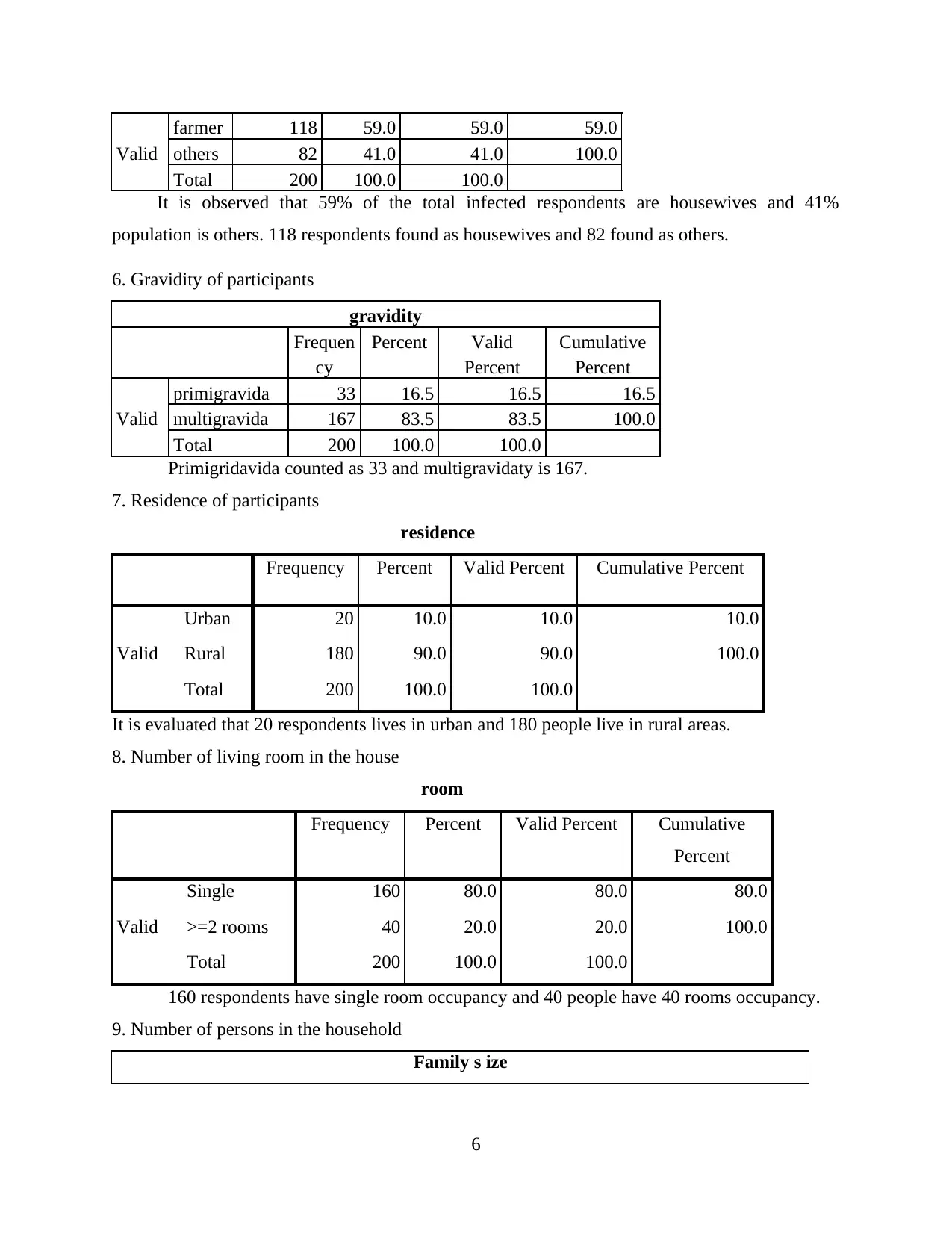
Valid
farmer 118 59.0 59.0 59.0
others 82 41.0 41.0 100.0
Total 200 100.0 100.0
It is observed that 59% of the total infected respondents are housewives and 41%
population is others. 118 respondents found as housewives and 82 found as others.
6. Gravidity of participants
gravidity
Frequen
cy
Percent Valid
Percent
Cumulative
Percent
Valid
primigravida 33 16.5 16.5 16.5
multigravida 167 83.5 83.5 100.0
Total 200 100.0 100.0
Primigridavida counted as 33 and multigravidaty is 167.
7. Residence of participants
residence
Frequency Percent Valid Percent Cumulative Percent
Valid
Urban 20 10.0 10.0 10.0
Rural 180 90.0 90.0 100.0
Total 200 100.0 100.0
It is evaluated that 20 respondents lives in urban and 180 people live in rural areas.
8. Number of living room in the house
room
Frequency Percent Valid Percent Cumulative
Percent
Valid
Single 160 80.0 80.0 80.0
>=2 rooms 40 20.0 20.0 100.0
Total 200 100.0 100.0
160 respondents have single room occupancy and 40 people have 40 rooms occupancy.
9. Number of persons in the household
Family s ize
6
farmer 118 59.0 59.0 59.0
others 82 41.0 41.0 100.0
Total 200 100.0 100.0
It is observed that 59% of the total infected respondents are housewives and 41%
population is others. 118 respondents found as housewives and 82 found as others.
6. Gravidity of participants
gravidity
Frequen
cy
Percent Valid
Percent
Cumulative
Percent
Valid
primigravida 33 16.5 16.5 16.5
multigravida 167 83.5 83.5 100.0
Total 200 100.0 100.0
Primigridavida counted as 33 and multigravidaty is 167.
7. Residence of participants
residence
Frequency Percent Valid Percent Cumulative Percent
Valid
Urban 20 10.0 10.0 10.0
Rural 180 90.0 90.0 100.0
Total 200 100.0 100.0
It is evaluated that 20 respondents lives in urban and 180 people live in rural areas.
8. Number of living room in the house
room
Frequency Percent Valid Percent Cumulative
Percent
Valid
Single 160 80.0 80.0 80.0
>=2 rooms 40 20.0 20.0 100.0
Total 200 100.0 100.0
160 respondents have single room occupancy and 40 people have 40 rooms occupancy.
9. Number of persons in the household
Family s ize
6
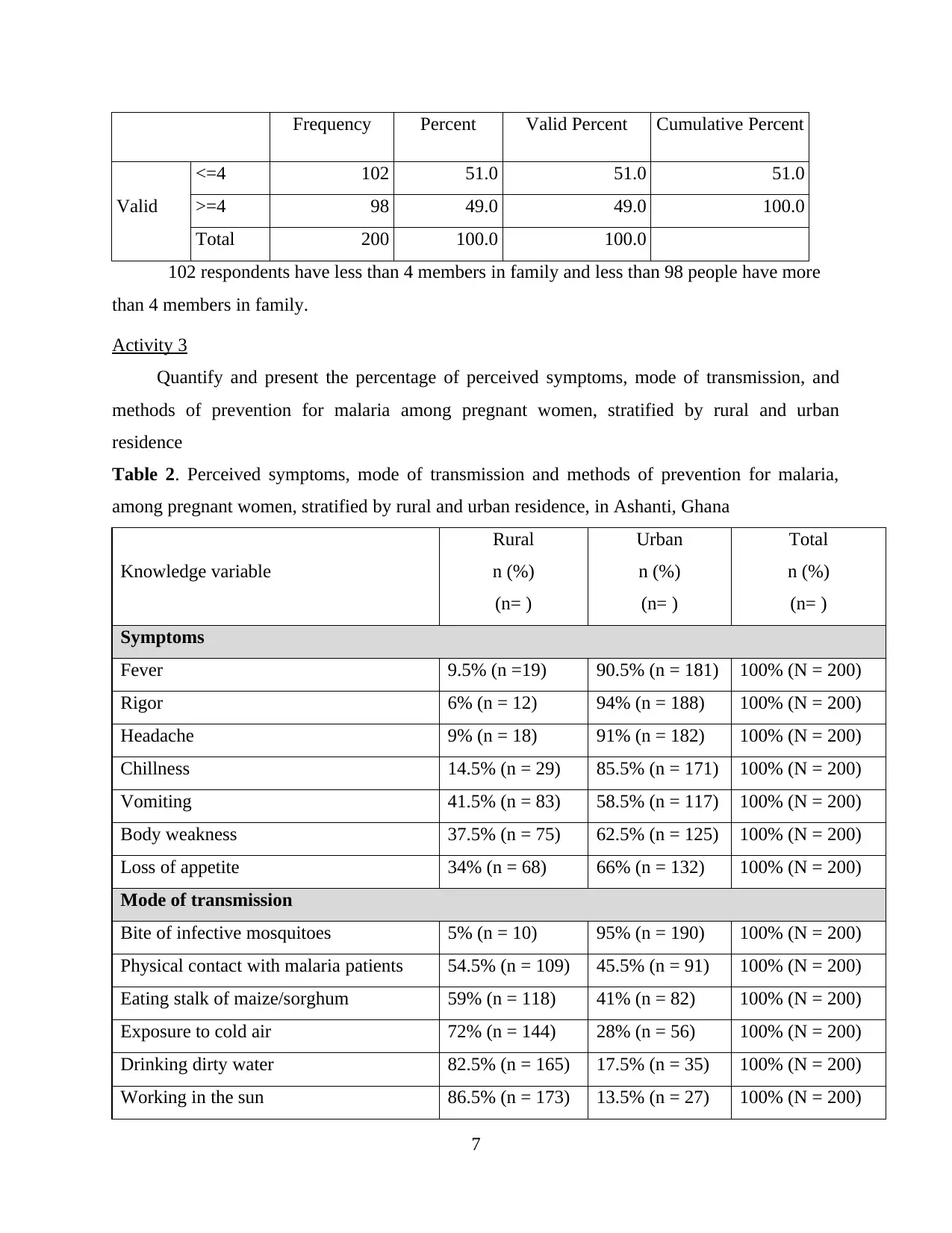
Frequency Percent Valid Percent Cumulative Percent
Valid
<=4 102 51.0 51.0 51.0
>=4 98 49.0 49.0 100.0
Total 200 100.0 100.0
102 respondents have less than 4 members in family and less than 98 people have more
than 4 members in family.
Activity 3
Quantify and present the percentage of perceived symptoms, mode of transmission, and
methods of prevention for malaria among pregnant women, stratified by rural and urban
residence
Table 2. Perceived symptoms, mode of transmission and methods of prevention for malaria,
among pregnant women, stratified by rural and urban residence, in Ashanti, Ghana
Knowledge variable
Rural
n (%)
(n= )
Urban
n (%)
(n= )
Total
n (%)
(n= )
Symptoms
Fever 9.5% (n =19) 90.5% (n = 181) 100% (N = 200)
Rigor 6% (n = 12) 94% (n = 188) 100% (N = 200)
Headache 9% (n = 18) 91% (n = 182) 100% (N = 200)
Chillness 14.5% (n = 29) 85.5% (n = 171) 100% (N = 200)
Vomiting 41.5% (n = 83) 58.5% (n = 117) 100% (N = 200)
Body weakness 37.5% (n = 75) 62.5% (n = 125) 100% (N = 200)
Loss of appetite 34% (n = 68) 66% (n = 132) 100% (N = 200)
Mode of transmission
Bite of infective mosquitoes 5% (n = 10) 95% (n = 190) 100% (N = 200)
Physical contact with malaria patients 54.5% (n = 109) 45.5% (n = 91) 100% (N = 200)
Eating stalk of maize/sorghum 59% (n = 118) 41% (n = 82) 100% (N = 200)
Exposure to cold air 72% (n = 144) 28% (n = 56) 100% (N = 200)
Drinking dirty water 82.5% (n = 165) 17.5% (n = 35) 100% (N = 200)
Working in the sun 86.5% (n = 173) 13.5% (n = 27) 100% (N = 200)
7
Valid
<=4 102 51.0 51.0 51.0
>=4 98 49.0 49.0 100.0
Total 200 100.0 100.0
102 respondents have less than 4 members in family and less than 98 people have more
than 4 members in family.
Activity 3
Quantify and present the percentage of perceived symptoms, mode of transmission, and
methods of prevention for malaria among pregnant women, stratified by rural and urban
residence
Table 2. Perceived symptoms, mode of transmission and methods of prevention for malaria,
among pregnant women, stratified by rural and urban residence, in Ashanti, Ghana
Knowledge variable
Rural
n (%)
(n= )
Urban
n (%)
(n= )
Total
n (%)
(n= )
Symptoms
Fever 9.5% (n =19) 90.5% (n = 181) 100% (N = 200)
Rigor 6% (n = 12) 94% (n = 188) 100% (N = 200)
Headache 9% (n = 18) 91% (n = 182) 100% (N = 200)
Chillness 14.5% (n = 29) 85.5% (n = 171) 100% (N = 200)
Vomiting 41.5% (n = 83) 58.5% (n = 117) 100% (N = 200)
Body weakness 37.5% (n = 75) 62.5% (n = 125) 100% (N = 200)
Loss of appetite 34% (n = 68) 66% (n = 132) 100% (N = 200)
Mode of transmission
Bite of infective mosquitoes 5% (n = 10) 95% (n = 190) 100% (N = 200)
Physical contact with malaria patients 54.5% (n = 109) 45.5% (n = 91) 100% (N = 200)
Eating stalk of maize/sorghum 59% (n = 118) 41% (n = 82) 100% (N = 200)
Exposure to cold air 72% (n = 144) 28% (n = 56) 100% (N = 200)
Drinking dirty water 82.5% (n = 165) 17.5% (n = 35) 100% (N = 200)
Working in the sun 86.5% (n = 173) 13.5% (n = 27) 100% (N = 200)
7
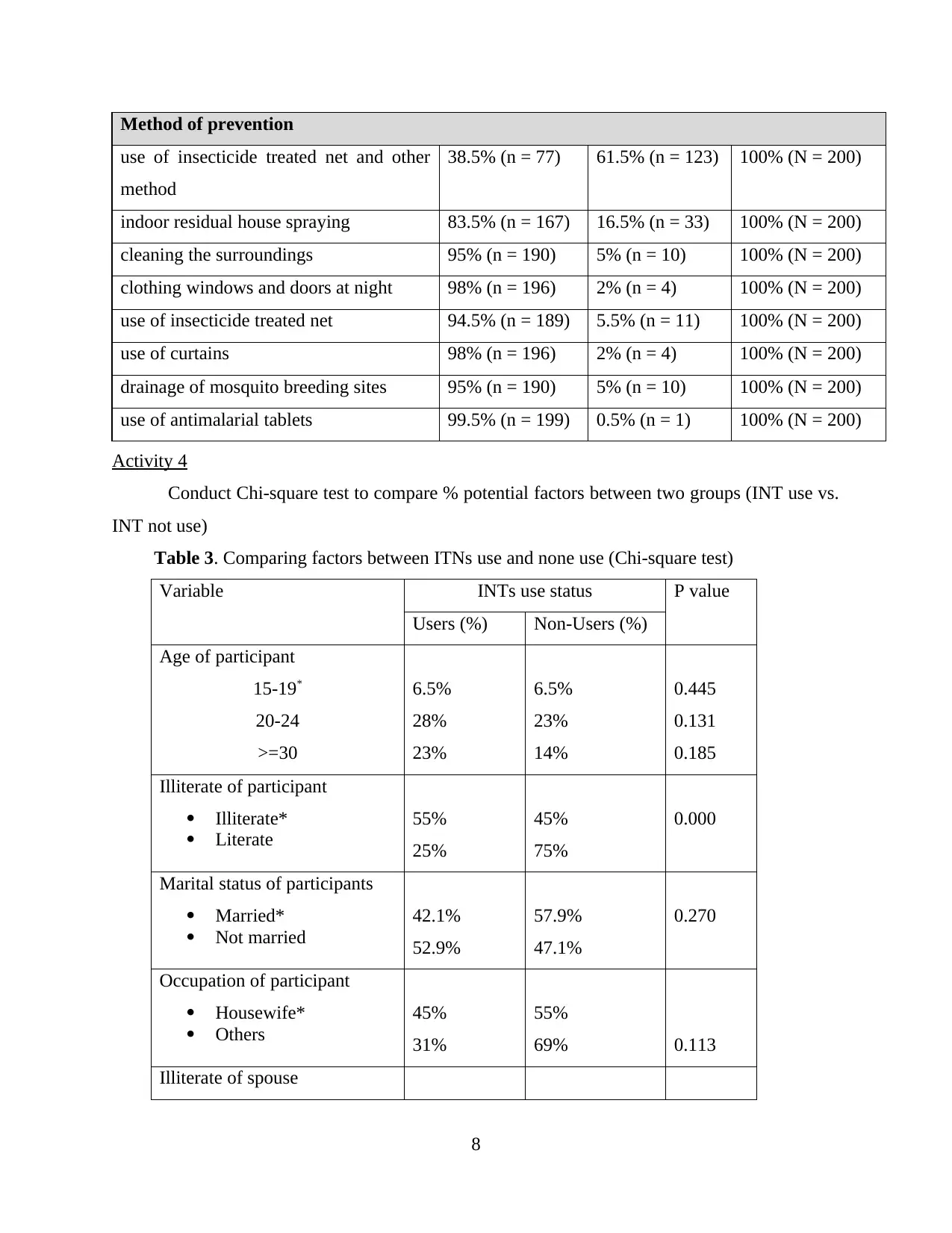
Method of prevention
use of insecticide treated net and other
method
38.5% (n = 77) 61.5% (n = 123) 100% (N = 200)
indoor residual house spraying 83.5% (n = 167) 16.5% (n = 33) 100% (N = 200)
cleaning the surroundings 95% (n = 190) 5% (n = 10) 100% (N = 200)
clothing windows and doors at night 98% (n = 196) 2% (n = 4) 100% (N = 200)
use of insecticide treated net 94.5% (n = 189) 5.5% (n = 11) 100% (N = 200)
use of curtains 98% (n = 196) 2% (n = 4) 100% (N = 200)
drainage of mosquito breeding sites 95% (n = 190) 5% (n = 10) 100% (N = 200)
use of antimalarial tablets 99.5% (n = 199) 0.5% (n = 1) 100% (N = 200)
Activity 4
Conduct Chi-square test to compare % potential factors between two groups (INT use vs.
INT not use)
Table 3. Comparing factors between ITNs use and none use (Chi-square test)
Variable INTs use status P value
Users (%) Non-Users (%)
Age of participant
15-19*
20-24
>=30
6.5%
28%
23%
6.5%
23%
14%
0.445
0.131
0.185
Illiterate of participant
Illiterate*
Literate
55%
25%
45%
75%
0.000
Marital status of participants
Married*
Not married
42.1%
52.9%
57.9%
47.1%
0.270
Occupation of participant
Housewife*
Others
45%
31%
55%
69% 0.113
Illiterate of spouse
8
use of insecticide treated net and other
method
38.5% (n = 77) 61.5% (n = 123) 100% (N = 200)
indoor residual house spraying 83.5% (n = 167) 16.5% (n = 33) 100% (N = 200)
cleaning the surroundings 95% (n = 190) 5% (n = 10) 100% (N = 200)
clothing windows and doors at night 98% (n = 196) 2% (n = 4) 100% (N = 200)
use of insecticide treated net 94.5% (n = 189) 5.5% (n = 11) 100% (N = 200)
use of curtains 98% (n = 196) 2% (n = 4) 100% (N = 200)
drainage of mosquito breeding sites 95% (n = 190) 5% (n = 10) 100% (N = 200)
use of antimalarial tablets 99.5% (n = 199) 0.5% (n = 1) 100% (N = 200)
Activity 4
Conduct Chi-square test to compare % potential factors between two groups (INT use vs.
INT not use)
Table 3. Comparing factors between ITNs use and none use (Chi-square test)
Variable INTs use status P value
Users (%) Non-Users (%)
Age of participant
15-19*
20-24
>=30
6.5%
28%
23%
6.5%
23%
14%
0.445
0.131
0.185
Illiterate of participant
Illiterate*
Literate
55%
25%
45%
75%
0.000
Marital status of participants
Married*
Not married
42.1%
52.9%
57.9%
47.1%
0.270
Occupation of participant
Housewife*
Others
45%
31%
55%
69% 0.113
Illiterate of spouse
8
Secure Best Marks with AI Grader
Need help grading? Try our AI Grader for instant feedback on your assignments.
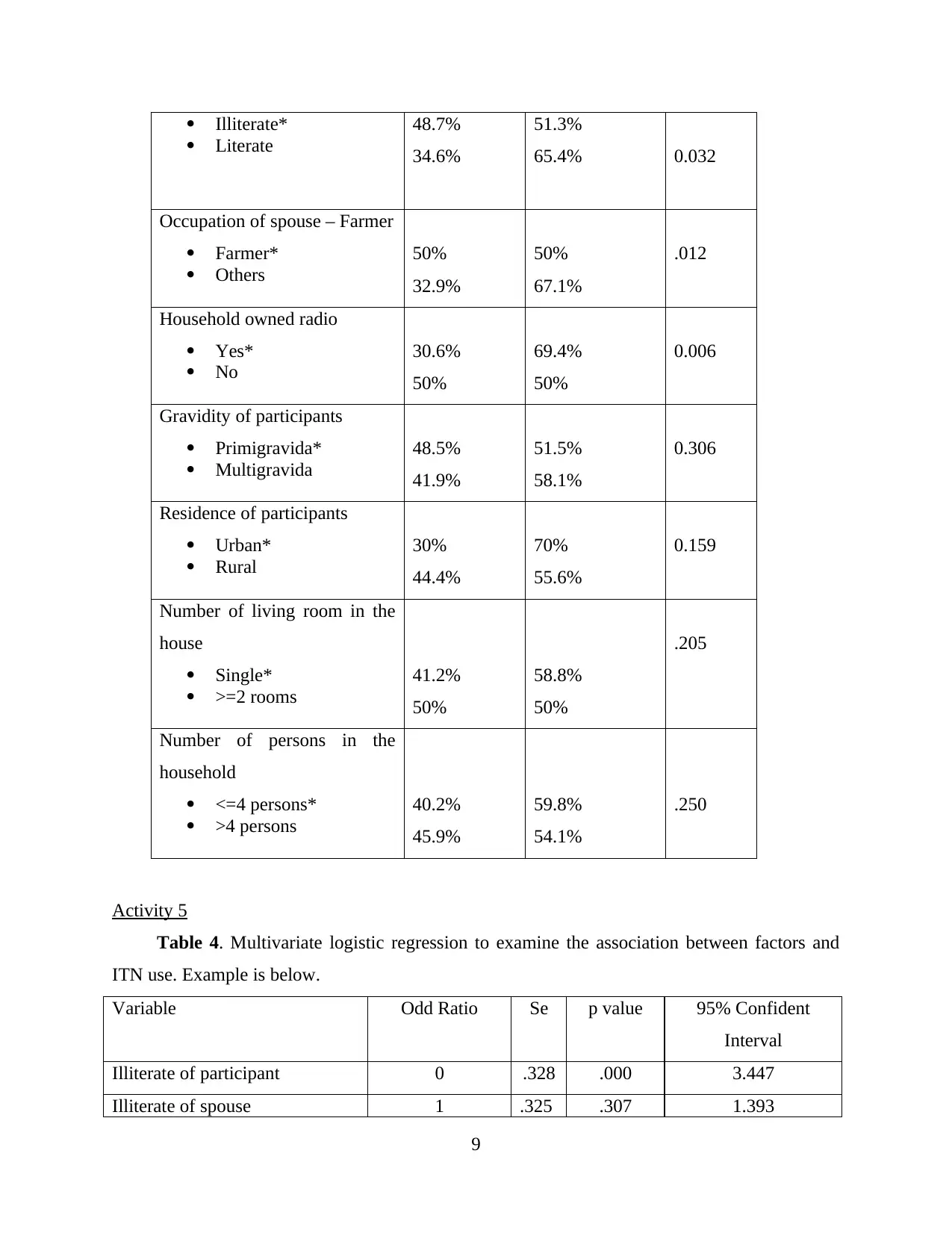
Illiterate*
Literate
48.7%
34.6%
51.3%
65.4% 0.032
Occupation of spouse – Farmer
Farmer*
Others
50%
32.9%
50%
67.1%
.012
Household owned radio
Yes*
No
30.6%
50%
69.4%
50%
0.006
Gravidity of participants
Primigravida*
Multigravida
48.5%
41.9%
51.5%
58.1%
0.306
Residence of participants
Urban*
Rural
30%
44.4%
70%
55.6%
0.159
Number of living room in the
house
Single*
>=2 rooms
41.2%
50%
58.8%
50%
.205
Number of persons in the
household
<=4 persons*
>4 persons
40.2%
45.9%
59.8%
54.1%
.250
Activity 5
Table 4. Multivariate logistic regression to examine the association between factors and
ITN use. Example is below.
Variable Odd Ratio Se p value 95% Confident
Interval
Illiterate of participant 0 .328 .000 3.447
Illiterate of spouse 1 .325 .307 1.393
9
Literate
48.7%
34.6%
51.3%
65.4% 0.032
Occupation of spouse – Farmer
Farmer*
Others
50%
32.9%
50%
67.1%
.012
Household owned radio
Yes*
No
30.6%
50%
69.4%
50%
0.006
Gravidity of participants
Primigravida*
Multigravida
48.5%
41.9%
51.5%
58.1%
0.306
Residence of participants
Urban*
Rural
30%
44.4%
70%
55.6%
0.159
Number of living room in the
house
Single*
>=2 rooms
41.2%
50%
58.8%
50%
.205
Number of persons in the
household
<=4 persons*
>4 persons
40.2%
45.9%
59.8%
54.1%
.250
Activity 5
Table 4. Multivariate logistic regression to examine the association between factors and
ITN use. Example is below.
Variable Odd Ratio Se p value 95% Confident
Interval
Illiterate of participant 0 .328 .000 3.447
Illiterate of spouse 1 .325 .307 1.393
9
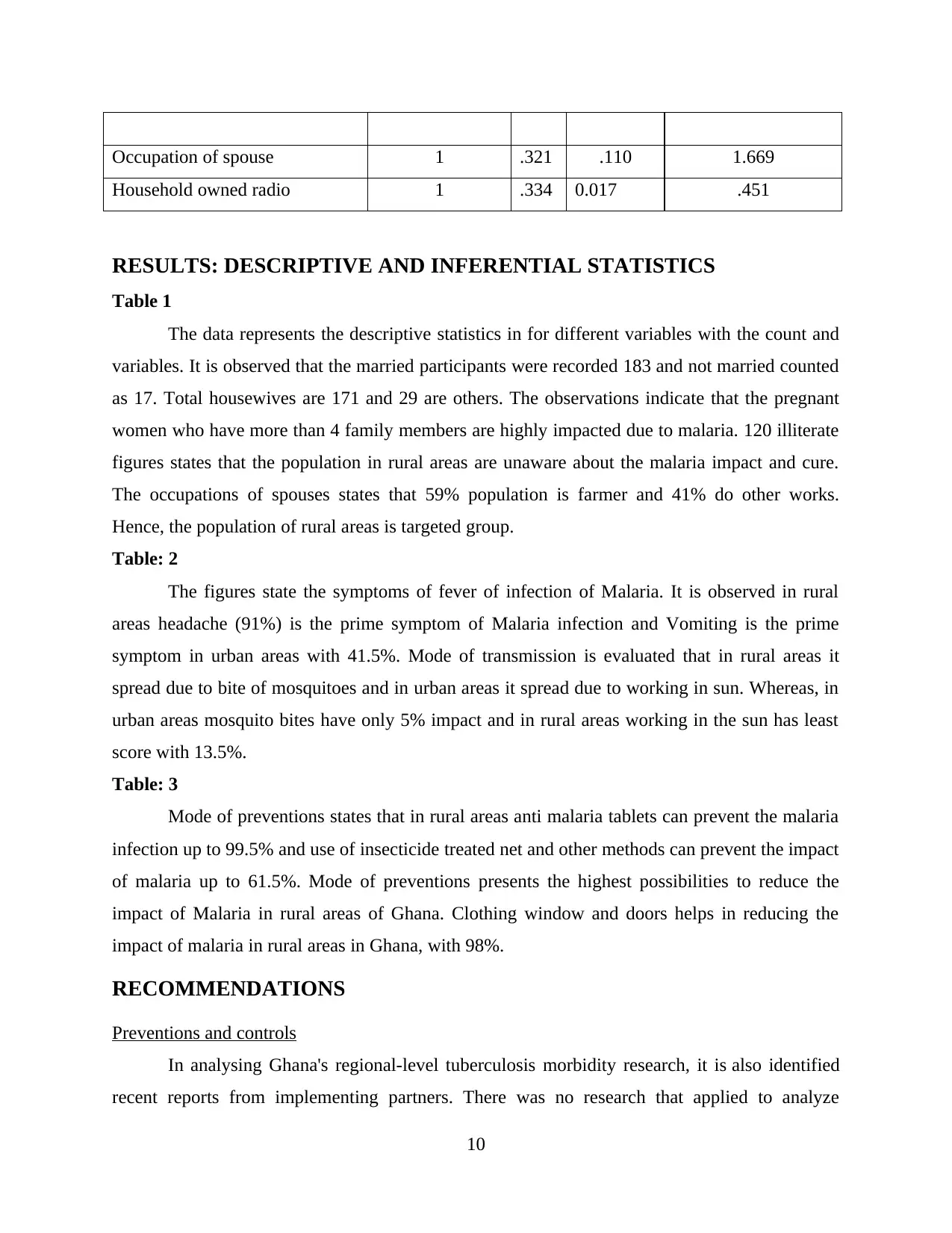
Occupation of spouse 1 .321 .110 1.669
Household owned radio 1 .334 0.017 .451
RESULTS: DESCRIPTIVE AND INFERENTIAL STATISTICS
Table 1
The data represents the descriptive statistics in for different variables with the count and
variables. It is observed that the married participants were recorded 183 and not married counted
as 17. Total housewives are 171 and 29 are others. The observations indicate that the pregnant
women who have more than 4 family members are highly impacted due to malaria. 120 illiterate
figures states that the population in rural areas are unaware about the malaria impact and cure.
The occupations of spouses states that 59% population is farmer and 41% do other works.
Hence, the population of rural areas is targeted group.
Table: 2
The figures state the symptoms of fever of infection of Malaria. It is observed in rural
areas headache (91%) is the prime symptom of Malaria infection and Vomiting is the prime
symptom in urban areas with 41.5%. Mode of transmission is evaluated that in rural areas it
spread due to bite of mosquitoes and in urban areas it spread due to working in sun. Whereas, in
urban areas mosquito bites have only 5% impact and in rural areas working in the sun has least
score with 13.5%.
Table: 3
Mode of preventions states that in rural areas anti malaria tablets can prevent the malaria
infection up to 99.5% and use of insecticide treated net and other methods can prevent the impact
of malaria up to 61.5%. Mode of preventions presents the highest possibilities to reduce the
impact of Malaria in rural areas of Ghana. Clothing window and doors helps in reducing the
impact of malaria in rural areas in Ghana, with 98%.
RECOMMENDATIONS
Preventions and controls
In analysing Ghana's regional-level tuberculosis morbidity research, it is also identified
recent reports from implementing partners. There was no research that applied to analyze
10
Household owned radio 1 .334 0.017 .451
RESULTS: DESCRIPTIVE AND INFERENTIAL STATISTICS
Table 1
The data represents the descriptive statistics in for different variables with the count and
variables. It is observed that the married participants were recorded 183 and not married counted
as 17. Total housewives are 171 and 29 are others. The observations indicate that the pregnant
women who have more than 4 family members are highly impacted due to malaria. 120 illiterate
figures states that the population in rural areas are unaware about the malaria impact and cure.
The occupations of spouses states that 59% population is farmer and 41% do other works.
Hence, the population of rural areas is targeted group.
Table: 2
The figures state the symptoms of fever of infection of Malaria. It is observed in rural
areas headache (91%) is the prime symptom of Malaria infection and Vomiting is the prime
symptom in urban areas with 41.5%. Mode of transmission is evaluated that in rural areas it
spread due to bite of mosquitoes and in urban areas it spread due to working in sun. Whereas, in
urban areas mosquito bites have only 5% impact and in rural areas working in the sun has least
score with 13.5%.
Table: 3
Mode of preventions states that in rural areas anti malaria tablets can prevent the malaria
infection up to 99.5% and use of insecticide treated net and other methods can prevent the impact
of malaria up to 61.5%. Mode of preventions presents the highest possibilities to reduce the
impact of Malaria in rural areas of Ghana. Clothing window and doors helps in reducing the
impact of malaria in rural areas in Ghana, with 98%.
RECOMMENDATIONS
Preventions and controls
In analysing Ghana's regional-level tuberculosis morbidity research, it is also identified
recent reports from implementing partners. There was no research that applied to analyze
10
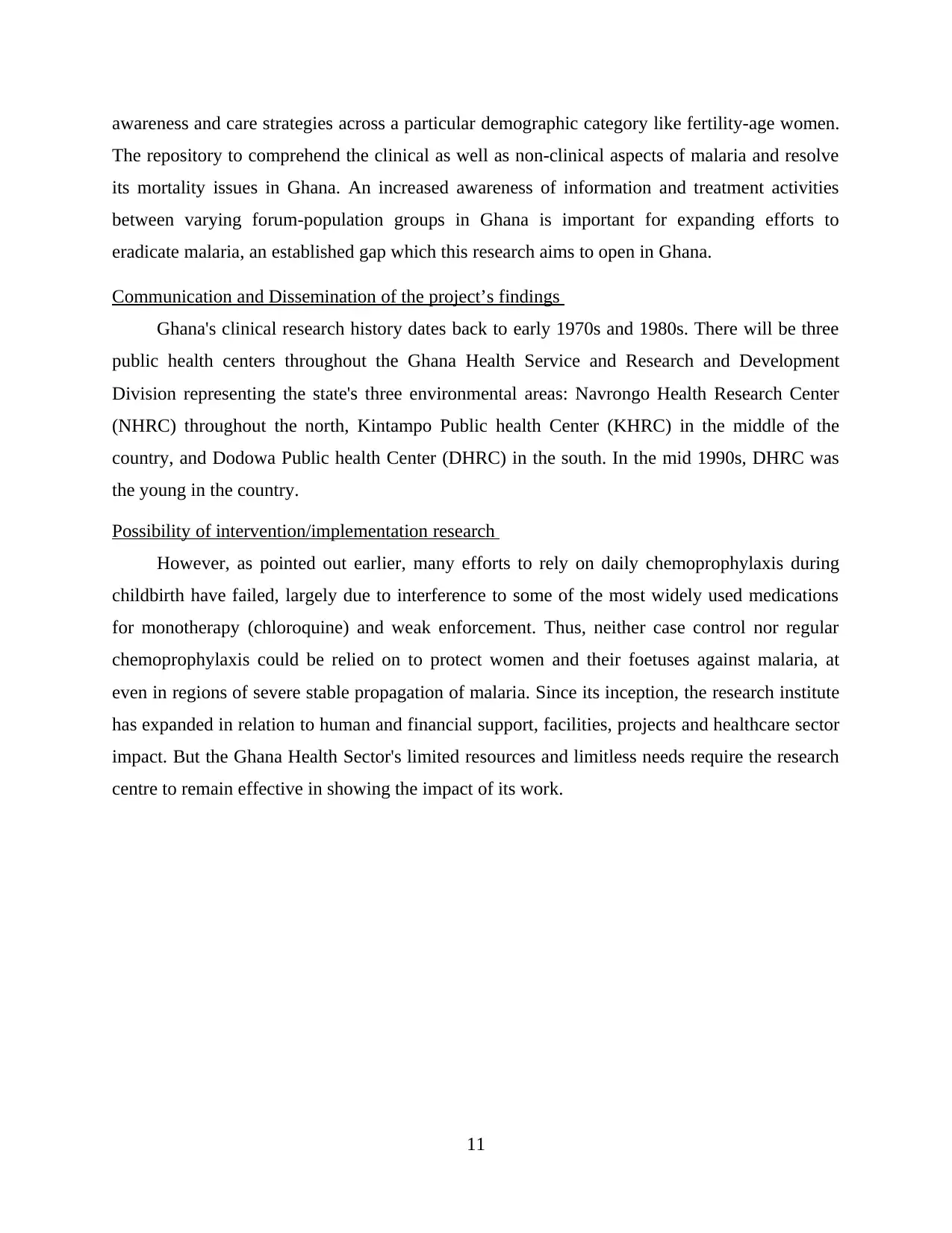
awareness and care strategies across a particular demographic category like fertility-age women.
The repository to comprehend the clinical as well as non-clinical aspects of malaria and resolve
its mortality issues in Ghana. An increased awareness of information and treatment activities
between varying forum-population groups in Ghana is important for expanding efforts to
eradicate malaria, an established gap which this research aims to open in Ghana.
Communication and Dissemination of the project’s findings
Ghana's clinical research history dates back to early 1970s and 1980s. There will be three
public health centers throughout the Ghana Health Service and Research and Development
Division representing the state's three environmental areas: Navrongo Health Research Center
(NHRC) throughout the north, Kintampo Public health Center (KHRC) in the middle of the
country, and Dodowa Public health Center (DHRC) in the south. In the mid 1990s, DHRC was
the young in the country.
Possibility of intervention/implementation research
However, as pointed out earlier, many efforts to rely on daily chemoprophylaxis during
childbirth have failed, largely due to interference to some of the most widely used medications
for monotherapy (chloroquine) and weak enforcement. Thus, neither case control nor regular
chemoprophylaxis could be relied on to protect women and their foetuses against malaria, at
even in regions of severe stable propagation of malaria. Since its inception, the research institute
has expanded in relation to human and financial support, facilities, projects and healthcare sector
impact. But the Ghana Health Sector's limited resources and limitless needs require the research
centre to remain effective in showing the impact of its work.
11
The repository to comprehend the clinical as well as non-clinical aspects of malaria and resolve
its mortality issues in Ghana. An increased awareness of information and treatment activities
between varying forum-population groups in Ghana is important for expanding efforts to
eradicate malaria, an established gap which this research aims to open in Ghana.
Communication and Dissemination of the project’s findings
Ghana's clinical research history dates back to early 1970s and 1980s. There will be three
public health centers throughout the Ghana Health Service and Research and Development
Division representing the state's three environmental areas: Navrongo Health Research Center
(NHRC) throughout the north, Kintampo Public health Center (KHRC) in the middle of the
country, and Dodowa Public health Center (DHRC) in the south. In the mid 1990s, DHRC was
the young in the country.
Possibility of intervention/implementation research
However, as pointed out earlier, many efforts to rely on daily chemoprophylaxis during
childbirth have failed, largely due to interference to some of the most widely used medications
for monotherapy (chloroquine) and weak enforcement. Thus, neither case control nor regular
chemoprophylaxis could be relied on to protect women and their foetuses against malaria, at
even in regions of severe stable propagation of malaria. Since its inception, the research institute
has expanded in relation to human and financial support, facilities, projects and healthcare sector
impact. But the Ghana Health Sector's limited resources and limitless needs require the research
centre to remain effective in showing the impact of its work.
11
1 out of 13
Related Documents
Your All-in-One AI-Powered Toolkit for Academic Success.
+13062052269
info@desklib.com
Available 24*7 on WhatsApp / Email
![[object Object]](/_next/static/media/star-bottom.7253800d.svg)
Unlock your academic potential
© 2024 | Zucol Services PVT LTD | All rights reserved.





